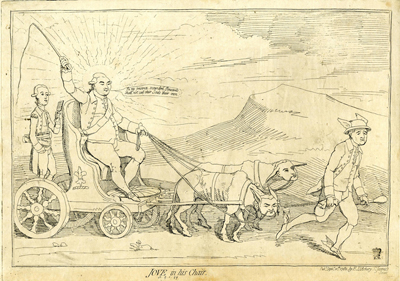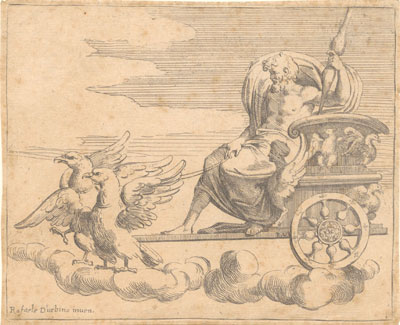Jove in his Chair
This is one of many prints by Gillray in 1782 exploring the aftermath of the sudden and unexpcted death of the Prime Minister Charles Watson-Wentworth, 2nd Marquess of Rockingham on July 1st, 1782. Most of those prints focus on Charles James Fox who, when the King appointed the Earl of Shelburne as Rockingham's successor, made the momentous and ill-fated descision to resign from his office and refuse to serve under Shelburne. In Gloria Mundi. . ., for instance, we see Fox as Milton's Satan looking up in envy at Shelburne whose image, as it is here, is irradiated by the sun of royal favor.

© Trustees of the British Museum
Jove in his Chair, on the other hand, focuses upon Shelburne, the King's favored candidate and what ought to have been a triumphal procession just two months after becoming Prime Minister. Gillray parodies "serious" paintings and prints of classical gods in their chariots drawn by noble beasts like eagles, dragons, or lions such as this one from the Royal Academy collection.

Jupiter in his Chariot
[ 1645-69]
© Royal Academy of Arts
But the implicit comparison only serves to emphasize how far this Jove and his train have fallen from the classical ideal. Instead of being drawn by mythologically appropriate eagles, Shelburne's chair is drawn by defeated-looking asses with the faces of two of Shelburne's supporters: John Dunning, Chancellor of the Duchy of Lancaster, and Henry Seymour Conway, Commander-in-Chief of the Forces. A month earlier in The Jubilee, Gillray had portrayed Conway blindfolded and being led by the nose by a two-faced Shelburne, who says:
Unthinking Fools! - who will as tenderly be led by the Nose, as Asses are - but if he... [Fox] scourged them with Whips! they shall find I will chastise them with Scorpions!
Now in Jove in his Chair, that image has almost come to pass. Shelburne is shown pitiless with whip in hand relishing his supreme power over the very souls of his train. The implication is that Dunning and Conway are asses in more ways than one.
The other two members of Shelburne's retinue seem to be equally naive and/or unhappy. The 23 year old William Pitt, Shelbourne's new Chancellor of the Exchequer, is identified by the two scrolls under his arm, one of which is inscribed [Chan]cellor of Excheqr. But he is characterized as a mere child, and a child of privilege at that, by the expensive ivory hornbook in his hand.
The last very unhappy figure is this ironic triumph is Isaac Barré identified, as the Btitish Museum commentary notes, by the bag in his hand labeled 3000 £, the approximate amount of his highly unpopular pension for acting as Treasurer of the Navy. He is portrayed as Mercury, the messenger god with winged cap and sandals, serving as a running footman for Shelburne. But as he leads the way, his eyes appear to be closed. (Barré was becoming blind from a war injury.)
Though Shelburne is shown basking in the sunshine of royal favor, he had a well-earned reputation for double-dealing and treachery. The fleur de lis on his chariot and the shield of Britannia under his feet may allude to the common belief that Shelburne's secret negotiations leading to the Peace of Paris (1783) were conceding too much to both France and America.
Sources and Reading
- Commentary from the British Museum on Jove in his Chair.
- "William Petty, 2nd Earl of Shelburne," Wikipedia
- "Shelburne ministry," Wikipedia
- "William Pitt the Younger," Wikipedia
- "Isaac Barré," Wikipedia
- "John Dunning, 1st Baron Ashburton," Wikipedia
- "Henry Seymour Conway," Wikipedia
- "Jupiter (mythology)," Wikipedia
- "Mercury (mythology)," Wikipedia
- Thomas Wright and Joseph Grego, The Works of James Gillray, the Caricaturist; With the History of His Life and Times, p. 42.
Comments & Corrections
NOTE: Comments and/or corrections are always appreciated. To make that easier, I have included a form below that you can use. I promise never to share any of the info provided without your express permission.